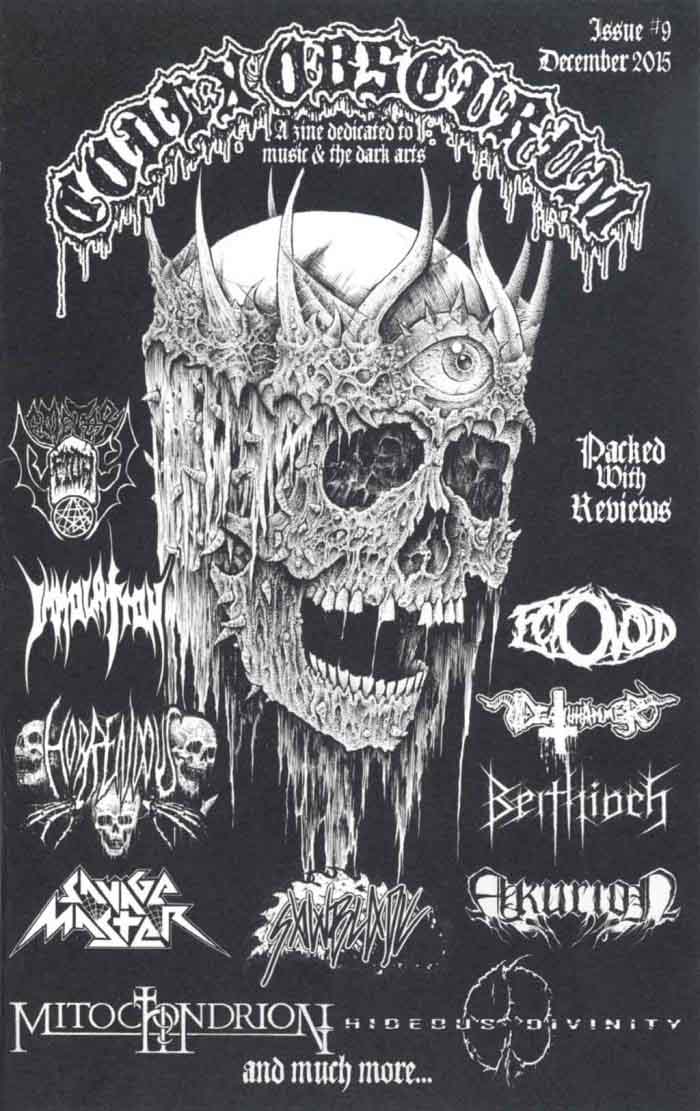
Codex Obscurum
Issue Nine
45 pages
As the internet reaches its peak, the inherent deficiencies of the post-“Eternal September” online audience reveal themselves. Drowning in vast amounts of MP3s and data, they have stopped choosing best over better, and simply accept whatever is not offensively horrible on the first listen. As a result music quality has plummeted. Zines like Codex Obscurum are reversing this by shining the spotlight on the quality that stands out and ignoring the rest of the flood.
Issue Nine opens with an Immolation interview. While I love Here in After, I usually skim Immolation interviews because the Ross & Bob show are so focused on being nice sociable guys that very little is said that I could not glean from liner notes. Interviewer Kevin Ord however takes a subtle but aggressive approach in asking Immolation “where’s the meat?” The result is unsatisfying, as one might expect for the band that defecated out Kingdom of Conspiracy, a parody of their former works worthy of SNL. Ord gets to the core of where this band is now and if there is an echo, it is not his fault but an honest reflection of what happens when death metal bands realize that two-note speed metal with death metal vocals is a path to Pantera-oriented glory where Here in After makes fans happy and bands poor.
Interviews follow with Mitochondrion, Horrendous, Evil Power, Ectovoid, Beithioch, Savage Master, Cemetery Filth, Hideous Divinity, Akurion and visual artist Daniel “Sawblade” Shaw. Each of these tries to bring out the purpose of the band, acknowledging subtly that many of these bands are B-level art workers who merely hope to pay tribute to their influences before going back to day jobs. Beithioch may be most interesting with its culture-based, whisky-infused Irish tangent on the idea of death metal and black metal as resurrection of the invisible values that hold humans together and keep us all from committing suicide in gas station restrooms. Each interview is carefully posed and diligently edited, filtering out the noise of grammatical train wrecks and misspellings that blight most zines.
After a centerfold of intense zine branding art, the reviews come forth. These are more descriptive than critical, but in trying to make a narrative out of each band, reveal how successful these artists are in expressing something more than a vague genre identity. Some of these reviews tempt as purpose and aesthetic vision appear in the words, but others make me want to run far away from what sounds like disorganized aping of the near-past. The reviewers are gentlemen who let the music speak for itself in symbolic translation instead of vocalizing their critiques, which makes it both more informative and more fun for the reader.
This issue ended too soon, but not for lack of content, but mainly because I was all set to read all night! Issue Nine ends in an editorial which by focusing on criticism of the underground, issues some potent criticism of its own of the underground, which is gratifying to see in a time when most people are too busy playing “follow the leader” to notice the quality differential over the years. It rounds out a solid issue and gives some placement to the interviews and reviews which preceded it.
Codex Obscurum continues at full strength after quite a few years now of activity, forging ahead where the internet has abandoned metal and the industry has failed it. This zine emphasizes selectivity and so has avoided treading the well-worn ruts that most big magazines do, but has also avoided the underground fanboi mentality which holds that a fifteenthrate Incantation/Demoncy imitation is just as much news as the originals. These writers have kept this zine going strong and show no sign of stopping, which makes it fortunate for us readers who need a breath of fresh air in the fetid stench of the decomposition of the corpse of the underground about now!
- Codex Obscurum – Issue Nine $3 + shipping
Tags: akurion, beithíoch, cemetery filth, codex obcurum, daniel shaw, death metal zines, ectovoid, Evil Power, hideious divinity, Horrendous, immolation, mitochondrion, savage master, sawblade, underground zines, zine, zines

